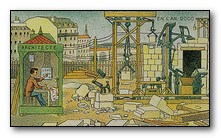It’s always amusing and often telling to compare where we are now to where we thought we’d be. Whether through sci-fi novels, advertisements for the house of the future, or in this case prints from an exhibition at the Bibliothèque nationale de France (bnf),  facets of the futurethink can provide a particularly prismatic view of past preoccupations. Paleo-Future Blog has a nice collection of images of life in the year 2000 from the BnF. Natalie has weighed in on how prescient these illustrations actually are.
facets of the futurethink can provide a particularly prismatic view of past preoccupations. Paleo-Future Blog has a nice collection of images of life in the year 2000 from the BnF. Natalie has weighed in on how prescient these illustrations actually are.
One thing that springs to my attention is the sense that the future was going to free us from contact with the ground. Flight seems to make so much more possible.  In a positive way, with long-distance cruise air-ships, our own personal flying vehicles, or apparatus enabling firemen to fight fires from the air and rescue those in distress. Realistically, the artist also recognizes the need for aerial police to maintain order in the newly crowded sky.
In a positive way, with long-distance cruise air-ships, our own personal flying vehicles, or apparatus enabling firemen to fight fires from the air and rescue those in distress. Realistically, the artist also recognizes the need for aerial police to maintain order in the newly crowded sky.
The complex is simplified through magical machines, whether the tailor who has a fully automated measuring machine that feeds dimensions to a second machine that takes fabric and turns out fully finished customized garments, or the barber who simply provides commentary as he manipulates a mechanical variant that cuts several patrons hair simultaneously.
 The view of school is very interesting, raw materials (books) are committed to a sausage grinder, where they are transformed into impulses and transmitted directly to learning caps on the heads of the students. (The unfortunate child who has to power the machine raises the question of who he is representing, being denied this pablumized knowledge). Are the books consumed by the process…they don’t seem to be emerging.
The view of school is very interesting, raw materials (books) are committed to a sausage grinder, where they are transformed into impulses and transmitted directly to learning caps on the heads of the students. (The unfortunate child who has to power the machine raises the question of who he is representing, being denied this pablumized knowledge). Are the books consumed by the process…they don’t seem to be emerging.
Is the architect directly carrying out the construction process a telling comment on the efficiency (and contribution) of the French labourer? Yet, the architect works from a plan, simply punching instructions into console, not merely crafting directly from inspiration.
 In all these images, the middle layer of intermediaries seem to be removed. Trades are eliminated through mechanization, but servitude is not. Professionals are empowered by progress, but are those eliminated raised up or cast down, or simply allowed a life of leisure able to indulge in endless frivolity such as the festival of the roses?
In all these images, the middle layer of intermediaries seem to be removed. Trades are eliminated through mechanization, but servitude is not. Professionals are empowered by progress, but are those eliminated raised up or cast down, or simply allowed a life of leisure able to indulge in endless frivolity such as the festival of the roses?
Questions aside, these visions suggest some of the problems that the artist perhaps saw as significant enough to warrant rectification.
The firemen with wings seem to speak to a fear of building heights and conflagration.
I am not sure of why, but strolling is expected, but otherwise having to walk is not acceptable. Thus, innovation such as powered skates if one has to mingle in the groundbound milieu. However, optimally streets have become a pedestrian only zone, as mechanized transport has moves to the air. Is this a comment on the initial results of the commingling of the mechanized and the pedestrian. The horse is missing from all pictures, except where it is seen purely as a curiosity.
 War has become very automated, and especially mobile, yet, the same French politicians of the time go on to construct the Mobile war…and yet the Maginot line springs from this same era.
War has become very automated, and especially mobile, yet, the same French politicians of the time go on to construct the Mobile war…and yet the Maginot line springs from this same era.
There is clearly a sense that communication and transportation will enable and that the then current pace stands in society’s way. More, faster, farther all seem to be demonstrated, but then these are the common hopes and expectations of society’s from early times. Its the other comments that can tell us much about the zeitgeist of 1910.
Check out the full exhibition as I have only chosen a few choice images.
